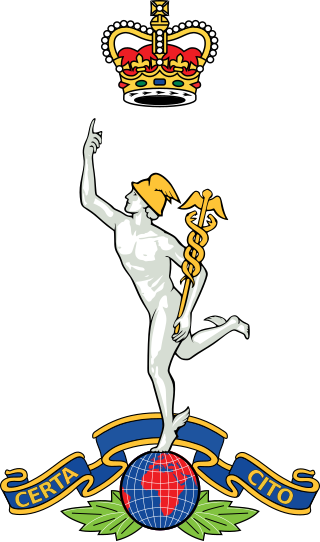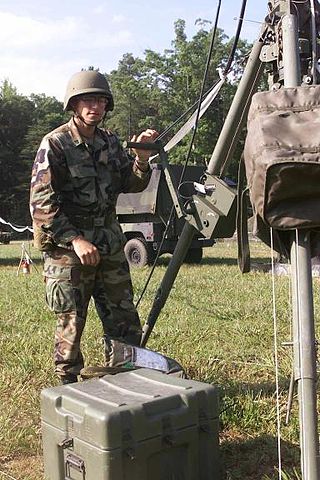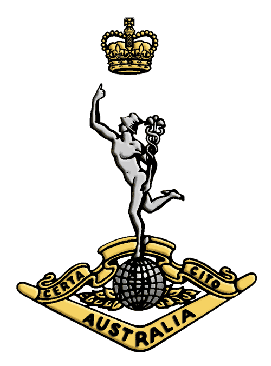Corps is a term used for several different kinds of organization. A military innovation by Napoleon I, the formation was first named as such in 1805. The size of a corps varies greatly, but two to five divisions and anywhere from 40,000 to 80,000 are the numbers stated by the US Department of Defense.

The Royal Corps of Signals is one of the combat support arms of the British Army. Signals units are among the first into action, providing the battlefield communications and information systems essential to all operations. Royal Signals units provide the full telecommunications infrastructure for the Army wherever they operate in the world. The Corps has its own engineers, logistics experts and systems operators to run radio and area networks in the field. It is responsible for installing, maintaining and operating all types of telecommunications equipment and information systems, providing command support to commanders and their headquarters, and conducting electronic warfare against enemy communications.
Ensign is a junior rank of a commissioned officer in the armed forces of some countries, normally in the infantry or navy. As the junior officer in an infantry regiment was traditionally the carrier of the regimental colours, the rank acquired the name. This rank has generally been replaced in army ranks by second lieutenant. Ensigns were generally the lowest-ranking commissioned officer, except where the rank of subaltern existed. In contrast, the Arab rank of ensign, لواء, liwa', derives from the command of units with an ensign, not the carrier of such a unit's ensign, and is today the equivalent of a major general.
A foreman of signals is a highly qualified senior NCO or warrant officer signals engineering manager in the Royal Corps of Signals of the British Army and other Commonwealth armies. They undertake the role of equipment care specialist, with additional responsibilities for engineering and technical project management sometimes.

A signaller, signalman, colloquially referred to as a radioman or signaleer in the armed forces is a specialist soldier, sailor or airman responsible for military communications. Signallers, a.k.a. Combat Signallers or signalmen or women, are commonly employed as radio or telephone operators, relaying messages for field commanders at the front line, through a chain of command which includes field headquarters. Messages are transmitted and received via a communications infrastructure comprising fixed and mobile installations.

The United States Army Signal Corps (USASC) is a branch of the United States Army that creates and manages communications and information systems for the command and control of combined arms forces. It was established in 1860, the brainchild of Major Albert J. Myer, and had an important role in the American Civil War. Over its history, it had the initial responsibility for portfolios and new technologies that were eventually transferred to other U.S. government entities. Such responsibilities included military intelligence, weather forecasting, and aviation.

An aircrew flying badge is the badge worn on the left breast, above any medal ribbons, by qualified aircrew in the Royal Air Force, Royal Navy, British Army, Indian Air Force, Pakistan Air Force, Royal Canadian Air Force, Royal Australian Navy, Australian Army, Royal Australian Air Force, Royal New Zealand Air Force, South African Air Force and Sri Lanka Air Force. An example of a real pilot brevet is as opposite:
The Royal Canadian Corps of Signals is a component within the Canadian Armed Forces' Communications and Electronics Branch, consisting of all members of that personnel branch who wear army uniform. Prior to 1968 it was a combat support corps of the Canadian Army. The Royal Canadian Corps of Signals was re-instituted in 2013. It provides communication support and information systems for the Canadian Army.

The Royal Australian Corps of Signals (RASigs) is one of the 'arms' of the Australian Army. It is responsible for installing, maintaining, and operating all types of telecommunications equipment and information systems. The motto of the Signals Corps is Certa Cito and is translated as 'Swift and Sure', signifying the aim of the signal service – that communication be carried out with maximum speed and certainty. Like their British counterparts, the Royal Australian Corps of Signals' flag and hat badge feature Mercury, the winged messenger of the gods, affectionately referred to by members of the corps as "Jimmy".

Cryptologic technician (CT) is a United States Navy enlisted rating or job specialty. The CT community performs a wide range of tasks in support of the national intelligence-gathering effort, with an emphasis on cryptology and signal intelligence related products.

The Communications and Electronics Branch is a personnel branch of the Canadian Armed Forces (CAF). The army component of the branch is designated the Royal Canadian Corps of Signals.
A yeoman was a member of an English social class, generally a freeman who owned his, or her, own farm. The term was also used in North America.

Blandford Camp is a military base comprising some 390 hectares of downland lying 2 miles north-east of Blandford Forum in the county of Dorset in southern England.

Bovington Camp is a British Army military base in Dorset, England. Together with Lulworth Camp it forms part of Bovington Garrison.
The Royal Signals trades are the employment specialisations of the Royal Corps of Signals in the British Army. Every soldier in the Corps is trained both as a field soldier and a tradesman. There are currently six different trades, all of which is open to both men and women:

A warrant officer (WO) in the British Armed Forces is a member of the highest-ranking group of non-commissioned ranks, holding the King's Warrant, which is signed by the Secretary of State for Defence.

The 14th Signal Regiment (Electronic Warfare) is a part of the British Army's Royal Corps of Signals. The regiment's role is to provide electronic warfare (EW) capability in support of deployed Land Commanders, in order to enable operations in the electronic battlespace. It is the only British Army regiment capable of conducting sustainable electronic warfare in support of national operations worldwide. The regiment is currently based at Cawdor Barracks, on the site of the former RAF Brawdy, near Haverfordwest, in South Wales.

The page contains the current structure of the British Army. The British Army is currently being reorganised to the Future Soldier structure.

The 12th Signal Brigade, later 12th Signal Group was a military communications formation of the British Army commanding regiments of the Royal Corps of Signals. Initially formed in 1967, the brigade would provide rear defence communications for the British Army of the Rhine until its disbandment in 1992. In 2004, the group was reformed to provide territorial army and rear support to the Allied Rapid Reaction Corps in Germany. However, in 2009 the group was disbanded following reductions to the Royal Corps of Signals and Territorial Army.

224 Signal Squadron (Cyber) is a company sized military communications unit of the British Army's Royal Corps of Signals and forms part of the corps' new 13th (Cyber) Signal Regiment. The squadron was originally formed in 1959 as part of the army's wider expansion of the Royal Signals, but disbanded in 1980 afters its tasks were taken over by a joint communications training group. In 2020, the squadron was reformed as part of the June 2020 reorganisation of the corps.












